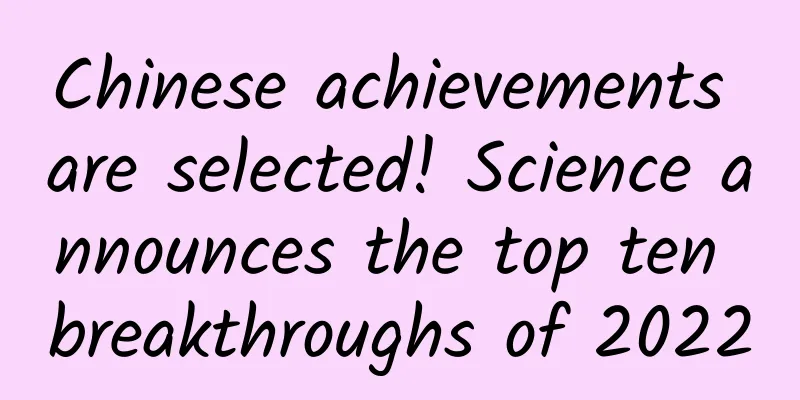Chinese achievements are selected! Science announces the top ten breakthroughs of 2022

|
On December 16, 2022, the American magazine Science released a list of the top ten scientific breakthroughs of the year. Among them, the development of China's perennial rice varieties was selected . Perennial rice can save farmers weeks of hard work every year. Image source: Science website In November 2022, Hu Fengyi's team from Yunnan University in China, in collaboration with relevant teams at home and abroad, published a research paper titled "Sustainable Productivity and Production Potential of Perennial Rice" in the internationally renowned academic journal Nature Sustainability, and simultaneously published a research brief titled "Perennial Rice Transformation Promotes Sustainable Agriculture". The team's Perennial Rice 23 (PR23) can be harvested without tillage for 3-4 years after planting once. That means from the second season onwards, there is no need for production steps such as buying seeds, raising seedlings, plowing and transplanting. Only two production steps are needed: field management and harvesting. This saves production costs and reduces labor. It is a milestone in the field of perennial food crop cultivation based on interspecific hybridization. In addition, after countless setbacks, 20 years of development, a whopping $10 billion in expenses, and a dangerous 1.5 million-kilometer journey through space, the new James Webb Space Telescope (JWST) has finally opened its golden infrared eyes, glimpsing the universe and its unfathomable past in stunning, unprecedented detail. To commemorate this feat, the American magazine Science has selected the flight of JWST as the top scientific breakthrough of 2022. Unhindered by Earth's atmosphere, the space telescope provides an undisturbed view of the universe around our planet. However, unlike its predecessor, the Hubble Space Telescope, JWST will capture infrared light, including that emitted by the first stars and galaxies. JWST's first deep field image depicts the galaxy cluster SMACS 0723, whose powerful gravity acts like a gravitational lens, magnifying the more distant galaxies behind it. The orange arcs are galaxies distorted by the lens. Image credit: European Space Agency/Canadian Space Agency/Space Telescope Science Institute Within days of its launch in late June 2022, researchers began discovering thousands of new galaxies that are more distant and older than any previously recorded, some of which may be more than 150 million years older than the oldest galaxies discovered by Hubble. More importantly, JWST is able to collect enough light from celestial objects—from newborn stars to exoplanets—to reveal what they are made of and how they move through space. These data are beginning to reveal in great detail the atmospheric composition of planets hundreds of light years from Earth, opening up the possibility of studying their ability to support life. The annual breakthrough list also includes: Discovery of a giant microbe nearly 5,000 times larger than many bacterial cells; New insights into how the Black Death altered the genetics of Europeans; Ancient ecosystems reconstructed from 2-million-year-old environmental DNA preserved in Greenland permafrost; Progress in respiratory syncytial virus vaccines; NASA successfully implemented the DART satellite mission; passing a landmark climate bill; the rapid development of creative artificial intelligence; Identify viruses that may cause multiple sclerosis. The top 10 breakthroughs of 2022 were selected by Science's news and editorial staff. A committee of about 10 people convened by Science's editor-in-chief, Holden Thorp, will also select up to three winners and award the inaugural Bhaumik Breakthrough of the Year Award in recognition of their unique contributions to relevant research fields. The list of individual winners will be announced by the end of March next year. |
<<: "Wukong" these seven years
>>: Why do the French call themselves Gallic Roosters?
Recommend
What are the benefits of precision and accuracy in activities from the perspective of activity costs?
Today, Strawberry would like to talk to you about...
Decoding the consumer psychology used by Pinduoduo in its promotions
You know exactly what to do to succeed, and then ...
How do internet celebrities monetize their traffic?
There are many ways for internet celebrities to m...
Google's disappointing plan to return to China!
[[154043]] There have been many reports that Goog...
It’s confirmed! Launch will take place at 9:31 a.m. tomorrow, and the astronaut crew has been announced!
On May 29, the China Manned Space Engineering Off...
Douyin live streaming course: take you from scratch to live streaming, learn what the anchor, operation, and central control should do respectively
Douyin live streaming course: take you from 0 to ...
Cherish entrepreneurship and stay away from entrepreneurial streets
[[132340]] In fact, when I was invited to join En...
Changsha Tianhe Tea High-end Tea Tasting High-quality Girls Live Audition Recommended Bring Your Own Studio Best Shared with Everyone
Changsha Tianhecha high-end tea tasting girls wit...
Insights into e-commerce information flow advertising in 2019!
The transaction volume of the Double Eleven battl...
De Ge's Stock Discussion: Thirteen Short-term Hot Money Lessons
De Ge's Stock Discussion: Thirteen Short-term...
How does the navigation app know that the red light is about to turn green?
With the continuous advancement of science and te...
Collection of 520 Internet Valentine's Day poster copywriting! Here’s a guide to picking up girls!
520 is here again, are you ready to confess your ...
From 0 to 20 million, the 3-year growth path of Get APP
1. Get the PMF of the app PMF, or product-market ...
SparkToro: Survey shows that nearly 30% of users use ChatGPT to assist in programming
What tasks do people mainly use ChatGPT to solve?...









